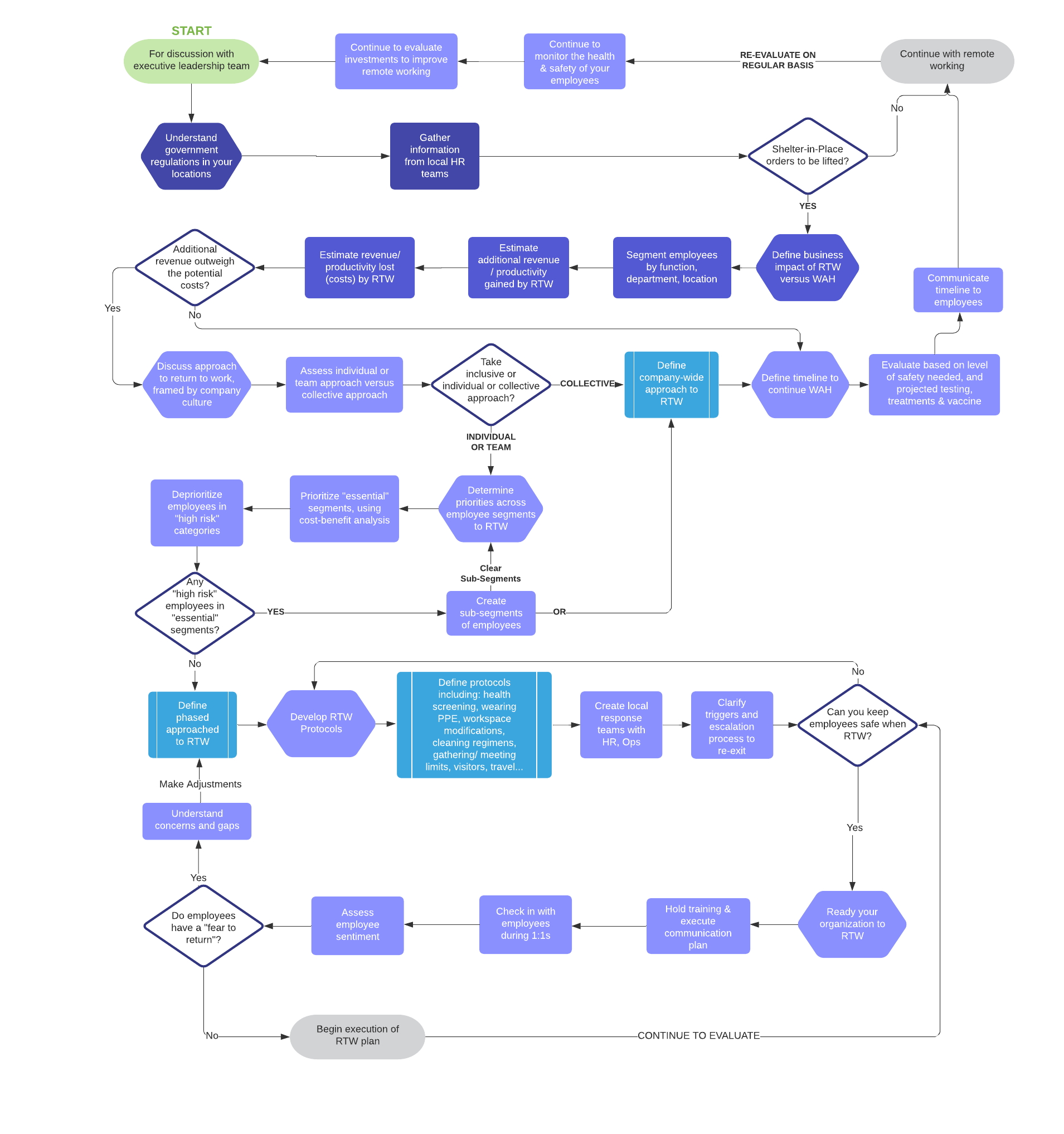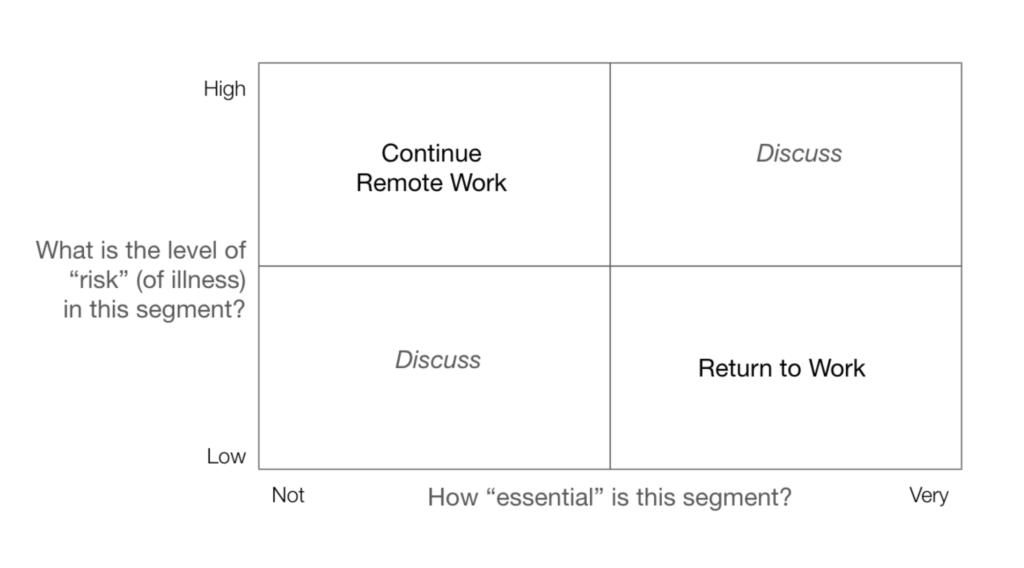As companies explore their options to return to the workplace before a vaccine is made available, several factors need to be considered to ensure your employees return to work safely. From city regulations to company culture to individual employee risks, these factors are complex and there is no one-size-fits-all answer.
As you navigate this topic, a Task Force is a good idea to organize information and drive the process forward. The decision to return to your workplace, we believe, should be made by a company’s leadership team. Returning is a life-death decision, and considerations need to be made for both the business and employee safety.
This guide outlines key decision points for your leadership team to help you make a Return to Workplace (RTW) decision. We have also included guidance for establishing new protocols at the office with references from other thought leaders on RTW sources.
Reflektive Return to Work Decision Tool

Start with Local Regulations
Local regulations will dictate when your office, factory, restaurant, etc. can re-open. Work with your Task Force and/or your local HR Team to understand regulations across each country, state, city, and local community. Be sure to consider a wider circumference than your place of work itself to include employees commuting.
Determine the Business Impact of Returning to Work vs. Working from Home
A cost-benefit analysis of remote work will vary based on your industry, workforce, access to technology, and location. In a COVID-19 Sentiment Survey by over 7,000 employees using Reflektive we found some unique differences. Here’s a framework to guide your decision-making process:
1. Segment your organization by department, role, and location
The business impact of working remotely can vary. Tech workers and financial services, for example, have adapted to this ‘new normal’ and found success moving to a remote working environment. Others, like dentistry and manufacturing, need to be on-premises to be most productive. Identify the right sub-segments in your organization and note potential differences in productivity.
2. Estimate the additional revenue or productivity gained by returning to the workplace
For each segment, identify lost productivity that results from remote work versus in-person interactions. In making this evaluation help normalize what the new working environment will look like (with social distancing, cleaning requirements, no/ limited meetings, etc.). Taking this new working environment into consideration, it’s likely the productivity gained may be less than initially estimated. A simple formula is:
Estimated Weekly Impact of Remote Work =
Estimated productivity loss %
x Number of employees
x Average weekly salary
3. Estimate the additional revenue or productivity Lost by returning to work
For each segment, identify potential risk of absenteeism and illness that could result from in-person interactions. We recommend the below formula:
Estimated Weekly Impact of Returning to Work =
Estimated infection rate %
x Number of employees
x Average weekly salary
x Minimum of 2 weeks
Outcome: Does the additional revenue outweigh the costs in a
material way to have some or all segments of our employees return to work?
As Gartner advised, “Decide based on the work, not the worker. At organizations where employees are remaining productive remotely, require managers to make the business case for returning them to an on-site location. Be flexible; well-informed guidelines rather than rigid mandates will ease stress on employees.” Be sure to challenge whether or not an investment in your digital strategy and technologies could narrow the gap and improve the productivity of employees working at home.
Discuss How you Return to the Workplace, Based on Your Company Culture
A key decision for your leadership team is to reflect on your company culture, and how that should shape the RTW.
Do you value individualism over teamwork and collectivism?
If your work culture emphasizes the group, belonging and inclusion rather than the individual, then you will want to make a company-wide determination about the RTW.
If Taking a Collective Approach, Determine the Company-Wide Approach
When bringing your whole company back together, share the date for the RTW, or when you will make a decision about the date.
Your RTW date should be based on workplace safety. Commonly referenced RTW requirements are a significant decline of COVID-19 cases, wide availability of testing, proven therapies, and ideally a vaccine.
Communicating your plan, staying informed of employee health, and evaluating investments to improve remote productivity will be central to your strategy.
If Taking an Individual or Team Approach, Prioritize Across Employee Segments
1. Prioritize “essential” segments, using cost-benefit analysis
Revisit your estimates on the business impact of RTW. For each employee segment, run a cost-benefit analysis and stack rank segments that present significant revenue gain with low risk for the RTW. Be sure to additionally evaluate based on increased costs that result from cleaning and other health and safety protocols needed to RTW.
2. Deprioritize employees in “High Risk” categories
There are multiple reasons why an employee would be of higher risk to return to work. Examples include:
• Serious underlying medical conditions
• Older adults
• Family obligations
• Commutes on public transportation
The CDC offers information on those of high risk and populations at greater risk of contracting COVID-19. We suggest mapping employees against a 2×2 matrix once you gather information for these two areas:

Ask yourself: Do you have any “high risk” employees in “essential” segments?
If you do, look to redefine your “essential” segments of employees into smaller sub-segments, noting that your benefit to returning will be reduced. Alternatively, consider revisiting the company-wide approach to RTW. Reasons that may sway you to do so would be the desire to maintain fairness and not discriminate against employees by age, family status, health, or other risk factors.
Define Phased Approach
For those employee segments that are “essential” and “low risk”, the next step is to define a planned approach to RTW. Protocols must be defined, including guidance on entrance screening, wearing of PPE, workspace modifications, cleaning and disinfection procedures, and more. There are several useful resources on this topic available at the end of this guide detailing these preparation steps.
Beyond your protocols, people, and processes are also central to a successful RTW. We recommend identifying local response teams that include members from HR and Operations. Worth noting that you want to be clear about the responsibilities of this response team and not ask they extend to health worker responsibilities that may be needed to successfully return employees to work safely. Additionally, clarify triggers and escalation procedures that would lead to a re-exit for some or all employees. Ultimately, the key question to ask is:
Can you keep employees safe when returning to work?
If the answer is, “yes” then you are ready to proceed. If the answer is, “no”, then protocols, people, and processes will need to be revisited.
Prepare your Organization
Training your workforce on the RTW protocols is crucial for this transition. The information needs to be clear, available in several communication channels, validated and confirmed before proceeding. Managers should use 1:1s with their direct reports to assess the comfort and confidence employees have in returning to work. This sentiment can also be identified in a brief pulse survey to employees. Sentiment should be viewed in aggregate, across segments, and then down to the individual level to determine:
Do employees have a “fear of return”?
If you identify “fear”, it’s a good signal to re-evaluate your phased approach to RTW. Identify the employee concerns and see if your company can reasonably address them. If not, re-evaluate the RTW strategy and decision with the rest of your leadership team.
Ready to Return to Work
If you identify employee confidence, then it’s time to move forward and begin executing your plan. However, the task force and leadership team should continuously monitor progress and evaluate risks and employee sentiment as changes in the status of outbreaks change regularly.
Additional References and Resources
- “The Back-to-Work Playbook” by Josh Bersin
- “Return-To-Workplace (RTW) Discussion Guide” by LifeLabs Learning
- “Return to Workplace Guide for Leaders” by Gartner
- “Essential COVID-19 Resources” by Think HR
- “Workforce Strategies for a Post-COVID-19 Recovery Workbook” by Deloitte
- “This twist on the four-day workweek could get people back to work without causing new outbreaks” by Fast Company
